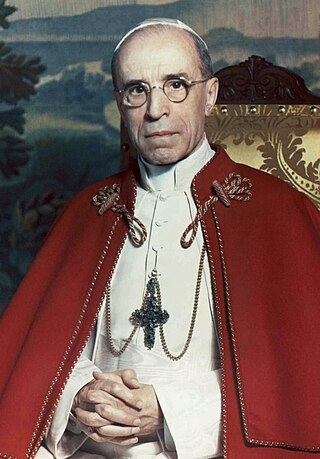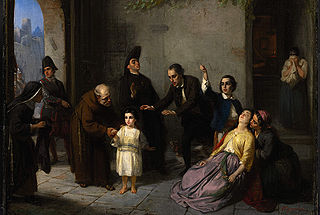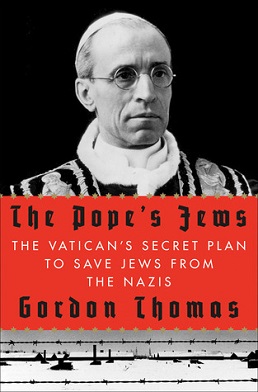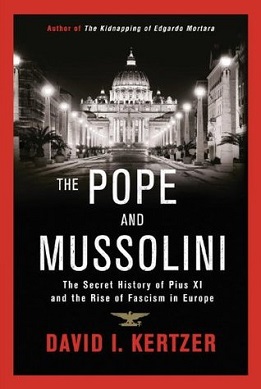
Pope Pius XII was head of the Catholic Church and sovereign of the Vatican City State from 2 March 1939 until his death in October 1958. Before his election to the papacy, he served as secretary of the Department of Extraordinary Ecclesiastical Affairs, papal nuncio to Germany, and Cardinal Secretary of State, in which capacity he worked to conclude treaties with various European and Latin American nations, including the Reichskonkordat treaty with the German Reich.

The Lateran Treaty was one component of the Lateran Pacts of 1929, agreements between the Kingdom of Italy under King Victor Emmanuel III and the Holy See under Pope Pius XI to settle the long-standing Roman Question. The treaty and associated pacts were named after the Lateran Palace where they were signed on 11 February 1929, and the Italian parliament ratified them on 7 June 1929. The treaty recognised Vatican City as an independent state under the sovereignty of the Holy See. The Italian government also agreed to give the Roman Catholic Church financial compensation for the loss of the Papal States. In 1948, the Lateran Treaty was recognized in the Constitution of Italy as regulating the relations between the state and the Catholic Church. The treaty was significantly revised in 1984, ending the status of Catholicism as the sole state religion.

Pope Pius XI, born Ambrogio Damiano Achille Ratti, was the Bishop of Rome and supreme pontiff of the Catholic Church from 6 February 1922 to 10 February 1939. He also became the first sovereign of the Vatican City State upon its creation as an independent state on 11 February 1929. He remained head of the Catholic Church until his death in February 1939. As his papal motto took the wording "Pax Christi in Regno Christi", translated "The Peace of Christ in the Kingdom of Christ".

The OVRA, whose most probable name was Organization for Vigilance and Repression of Anti-Fascism, was the secret police of the Kingdom of Italy, founded in 1927 under the regime of Fascist dictator Benito Mussolini and during the reign of King Victor Emmanuel III. The OVRA was the Italian precursor of the German Gestapo. Mussolini's secret police were assigned to stop any anti-fascist activity or sentiment. Approximately 50,000 OVRA agents infiltrated most aspects of domestic life in Italy. The OVRA, headed by Arturo Bocchini, never appeared in any official document, so the official name of the organization still remains unclear.

The Mortara case was an Italian cause célèbre that captured the attention of much of Europe and North America in the 1850s and 1860s. It concerned the Papal States' seizure of a six-year-old boy named Edgardo Mortara from his Jewish family in Bologna, on the basis of a former servant's testimony that she had administered an emergency baptism to the boy when he fell ill as an infant. Mortara grew up as a Catholic under the protection of Pope Pius IX, who refused his parents' desperate pleas for his return. Mortara eventually became a priest. The domestic and international outrage against the Pontifical State's actions contributed to its downfall amid the unification of Italy.
Clerical fascism is an ideology that combines the political and economic doctrines of fascism with clericalism. The term has been used to describe organizations and movements that combine religious elements with fascism, receive support from religious organizations which espouse sympathy for fascism, or fascist regimes in which clergy play a leading role.

Pietro Gasparri was a Roman Catholic cardinal, diplomat and politician in the Roman Curia and the signatory of the Lateran Pacts. He served also as Cardinal Secretary of State under Popes Benedict XV and Pope Pius XI.

Hitler's Pope is a book published in 1999 by the British journalist and author John Cornwell that examines the actions of Eugenio Pacelli, who became Pope Pius XII, before and during the Nazi era, and explores the charge that he assisted in the legitimization of Adolf Hitler's Nazi regime in Germany, through the pursuit of a Reichskonkordat in 1933. The book is critical of Pius' conduct during the Second World War, arguing that he did not do enough, or speak out enough, against the Holocaust. Cornwell argues that Pius's entire career as the nuncio to Germany, Cardinal Secretary of State, and Pope, was characterized by a desire to increase and centralize the power of the Papacy, and that he subordinated opposition to the Nazis to that goal. He further argues that Pius was antisemitic and that this stance prevented him from caring about the European Jews.

Włodzimierz Halka Ledóchowski was a Polish Catholic priest who served as the 26th Superior-General of the Society of Jesus from 11 February 1915 until his death in 1942. Prior to taking holy orders, he was briefly a page in the Habsburg Court.

Alois Karl Hudal was an Austrian bishop of the Catholic Church, based in Rome. For thirty years, he was the head of the Austrian-German congregation of Santa Maria dell'Anima in Rome and, until 1937, an influential representative of the Catholic Church in Austria.

Camillo Caccia-Dominioni was an Italian cardinal of the Roman Catholic Church. He served as prefect of the Pontifical Household from 1921 to 1935, and was elevated to the cardinalate in 1935.

Cesare Vincenzo Orsenigo was Apostolic Nuncio to Germany from 1930 to 1945, during the rise of Nazi Germany and World War II. Along with the German ambassador to the Vatican, Diego von Bergen and later Ernst von Weizsäcker, Orsenigo was the direct diplomatic link between Pope Pius XI and Pope Pius XII and the Nazi regime, meeting several times with Adolf Hitler directly and frequently with other high-ranking officials and diplomats.

The relations between Pope Pius XI and Judaism during his reign from 1922 to 1939 are generally regarded as good. The pontiff was particularly opposed to antisemitism, an important issue at the time when Nazi Germany was rising. Certain favourable opinions of Pius XI were subsequently used to attack the perceived silence of Pope Pius XII.

The papacy of Pius XII began on 2 March 1939 and continued to 9 October 1958, covering the period of the Second World War and the Holocaust, during which millions of Jews were murdered by Adolf Hitler's Germany. Before becoming pope, Cardinal Pacelli served as a Vatican diplomat in Germany and as Vatican Secretary of State under Pius XI. His role during the Nazi period has been closely scrutinised and criticised. His supporters argue that Pius employed diplomacy to aid the victims of the Nazis during the war and, through directing his Church to provide discreet aid to Jews and others, saved hundreds of thousands of lives. Pius maintained links to the German Resistance, and shared intelligence with the Allies. His strongest public condemnation of genocide was, however, considered inadequate by the Allied Powers, while the Nazis viewed him as an Allied sympathizer who had dishonoured his policy of Vatican neutrality.
Pietro Tacchi Venturi was a Jesuit priest and historian who served as the unofficial liaison between Benito Mussolini, the Fascist leader of Italy from 1922 to 1943, and Popes Pius XI and Pius XII. He was also one of the architects of the 1929 Lateran Treaty, which ended the "Roman Question", and recognized the sovereignty of Vatican City, which made it an actor of international relations. A claimed attempt to assassinate Venturi with a paper knife, one year before the treaty's completion, made headlines around the world. Venturi had begun the process of reconciliation by convincing Mussolini to donate the valuable library of the Palazzo Chigi to the Vatican.

Catholic resistance to Nazi Germany was a component of German resistance to Nazism and of Resistance during World War II. The role of the Catholic Church during the Nazi years remains a matter of much contention. From the outset of Nazi rule in 1933, issues emerged which brought the church into conflict with the regime and persecution of the church led Pope Pius XI to denounce the policies of the Nazi Government in the 1937 papal encyclical Mit brennender Sorge. His successor Pius XII faced the war years and provided intelligence to the Allies. Catholics fought on both sides in World War II and neither the Catholic nor Protestant churches as institutions were prepared to openly oppose the Nazi State.

The Pope's Jews: The Vatican's Secret Plan to Save Jews from the Nazis is a 2012 book by the British author Gordon Thomas concerning the efforts of Pope Pius XII to protect Jews during the Nazi Holocaust. The Observer reported in 2013 that "Gordon Thomas, a Protestant, was given access to previously unpublished Vatican documents and tracked down victims, priests and others who had not told their stories before" and had uncovered "evidence on Pius XII's wartime efforts to save Jewish refugees".

The Pope and Mussolini: The Secret History of Pius XI and the Rise of Fascism in Europe is a 2014 biography of Pope Pius XI about his relations with Benito Mussolini and rise of Fascism in Europe by David Kertzer. The book examined documentary evidence from the Vatican archives, arguing that Pope Pius XI played a significant role in supporting the rise of fascism and Benito Mussolini in Italy, but not of Nazism in Germany.
Kevin J. Madigan is an American historian and theologian. He has taught at Harvard University since 2000. A member of the Faculty of Divinity, he has also served on Harvard's Committee on the Study of Religion, the Medieval Studies Committee, and the Center for Jewish Studies. Since 2009, Madigan has been the Winn Professor of Ecclesiastical History at Harvard Divinity School, an appointment offered by then-Dean of HDS, William Graham, and officially approved by Harvard President Drew Gilpin Faust.
The Pius War refer to debates over the legacy of Pope Pius XII and his actions during the Holocaust. The phrase was first coined in a 2004 book of the same name.
















